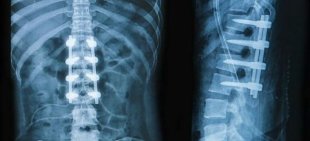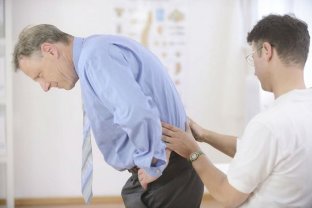Many people know the symptom "pain in the lower part of the back". Usually the discomfort associated with various diseases of the spine, but in practice it often turns out that the cause of the other. Often pain in the lower back occurs in women late in pregnancy as the spine experiences more stress than usual.
The reason can also be various diseases of the internal organs, degenerative changes in the bones cartilaginous apparatus the lower part of the back, etc. of Sedentary lifestyle, intense working conditions, professional sport, obesity can all cause pain in the lower part of the spine.
The lower part of the back doctors call the term "lumbalgia". It is a common phenomenon, which is characterized by the sudden appearance and disappearance of the pain syndrome. Some patients undergo a short course of treatment and never experience discomfort, others have to get treatment for several months or even years. To determine the exact reason for the pain in the lower back, should be examined first by the doctor, and then in his direction specialists.
Reasons
Most often low back pain is a symptom of various diseases of the musculoskeletal system. Often discomfort bother the people who spend a lot of time on the computer, in the car, doing heavy physical labor, throwing themselves at the gym. The risk group includes pregnant women or women who recently gave birth.
Diseases accompanied by pain in the lower back
Pain in the back bottom can indicate diseases such as osteochondrosis or spondylosis. It's called the primary causes of pain associated with functional and morphological changes of the spine.
Among the secondary causes of back pain are:
- neoplastic processes in the vertebrae, spinal cord;
- injuries of the vertebrae;
- the infectious process in the intervertebral discs and the vertebrae;
- metabolic disorders in the bones (osteoporosis, osteomalacia);
- inflammatory diseases of infectious etiology (rheumatoid arthritis, spondylitis);
- acute hemodynamic instability (e.g., in stroke);
- diseases associated with impaired development;
- gastrointestinal diseases (which are not typical for acute appendicitis, intestinal obstruction);
- kidney disease (urolithiasis pain behind the unilateral, most often on the right side);
- diseases of the organs in the pelvis.

Thus, the reason for the pain is not always rooted in the lesions of the musculoskeletal system. If the pain is caused by dysfunction of the internal organs, it is irradiating nature. In addition, in men back pain in the lower part of the spine in chronic prostatitis, the prostate cancer, although this symptom is not always required.
The pain may appear after a long walk that suggests spinal stenosis. The disease is manifested in the form of a syndrome of intermittent claudication. People, also, complained of cramps and pains in the pain when walking. The elderly the development of the condition as rheumatic polymyalgia. First, there is mild pain, then the feeling of numbness in the hands or feet.
The most common cause for pain below the waist, right side, left side or center is low in the back. Instrumental methods of investigation help to identify the different degenerative changes of the spinal column. In them the space between the discs of the spine gradually decreases, as a result of the development of the imbalance in the structure of the entire spine.
This leads to pain in the back, which are localized on the left or right, or go over the ridge.
Another source of back pain – the presence of intervertebral hernia. In the case of their injury, compression of the nerve roots there is quite a strong, sharp pain which is in the initial phase using steroid and non-steroidal anti-inflammatory drugs.
Symptom of the adverse outcome is lumbodynia, which is manifested by a number of symptoms. Pain along the nerve root can radiate into the buttocks and legs. Discomfort appears when bending (even when tilting the head down), laugh, cough, etc. Pain syndrome is worse when lifting lying on back straight legs.
Manifested as pain in the back
The symptoms of back pain is different depending on the existing pathology. When stretched, the pain manifests itself in the form of cramps, until the movement is limited. Syndrome the pain radiates towards the buttocks, the back of the thighs. It's hard to bend over to turn the case. If damaged roots give pain in the lower part of the body, may be disturbance of sensation, numbness.
Osteochondrosis symptoms increase gradually. At first, the pain bothers with one hand, her character is not expressed. With the development of the pathological pain process becomes stronger, harder stoped pain, affect a large area. After a long stay in a position of pain, pain in nature.
If kidney damage pain does not appear in the lower part of the back, approximately at the level of the 12 pair of ribs. However, in renal colic the pain radiates down syndrome, in the course of the ureter, gives the groin. The pain is unbearable, very strong analgesics do not help. The characteristic symptom is a unilateral localization.
Diagnosis
Why pain in the lower back, can be set only doctor. In no case should not engage in self-diagnosis and self-treatment. The diagnosis is based on patient complaints, clinical symptoms, anamnesis data, results of instrumental methods. The patient is prescribed with x-rays, myelography, MRI, CT and other types of surveys.
Computed tomography is an efficient and highly informative method for the detection of various structural changes of the spine caused by trauma, infectious process, tumor formation, osteoporosis and other diseases. On the basis myelography is the use of contrasting substances. The method used in cases of suspected spinal stenosis, hernia, tumors and other pathological processes in the spine.

Treatment
What to do if the back hurts, it can be said only by a qualified technician. Tactics of treatment depends on the cause of the pain. It is not recommended to use analgesics because they provide only a temporary effect (and in certain diseases of not help), the "lubricating" the clinical picture and exacerbate the disease process what the person is constantly removing the pain, the delay of the visit to the doctor.
The main principle of treatment – the treatment is not pain as such, but the reasons for it. So, osteochondrosis requires a large number of measures. Nonsteroidal anti-inflammatory drugs in this disease are used as symptomatic therapy in the period of the swing. Such drugs include Diclofenac, Nimesulide etc., but they have a number of contraindications (eg, peptic ulcer).
Also, you may have received a non-steroidal anti-inflammatory creams. In some cases, require steroid anti-inflammatory drugs. The main events are held in the period without exacerbation and medical gymnastics, completion therapeutic massage, organization of the correct day regimen and nutrition.
Additionally, the designated physiotherapy, acupuncture, chiropractic, etc. without exacerbation doctors recommend to do therapeutic exercises. This is the best way to strengthen your back, relieve tension and muscle spasm. The therapeutic physical exercises (physical therapy) is mandatory in the program for the prevention of back pain.
Classes are best done under the supervision of the instructor, but some simple exercises it is possible to perform at home:
- Lie on your back, arms stretched along the body, legs slightly bent in the knee joints. The legs to deflect to the right in the body and head turn slightly to the left (the main thing – do not overdo it). After five seconds, return to starting position, repeat the same with the opposite side. A total of ten repetitions.
- To get on my knees to lean on the chair. Arch your back upwards, then the maximum SAG. To do ten repetitions.
- Lie on your back, straighten your legs. Raise the right leg 20 cm above the floor, hold until fatigue. The same is done with the left foot. Do five repetitions for each leg.
Good effect gives massage and manual therapy. These procedures are performed only by a qualified technician. Improper execution of the violation of technician behavior can cause significant damage. During the session of manual therapy of the hands of a specialist go through the whole back area, which affect different levels (fascia, bone structure, etc.).
Special attention is given to the neural level. Specialist has a direct effect on neurons through palpatory manipulation. A chiropractor is able to slow down or speed up the nerve chain. Recently the growing popularity of acupuncture. The course consists of several procedures and is in the direction of pain relief and muscle relaxation.
In the presence of excess weight need to be diet. Preference should be given to herbal, low-calorie food. Proteins are one third of the daily diet. You can eat lean fish, poultry, meat, eggs. Also, the protein contained in legumes, buckwheat, mushrooms, fruits (with them it is important not to overdo it). Fat you need to consume unsaturated (lamb, white fish, nuts, vegetable oils).
In diseases of the osteoarticular system, the important role played by vitamins a and D. Vitamin A can be found in vegetables, onions, vegetables, orange and yellow colors, cod liver oil, liver, egg yolks. Vitamin D is synthesized under the influence of the sun's rays. It is also possible to obtain small amounts of milk, butter, egg yolks, cod liver, caviar. For the health of bones need to consume the proper amount of phosphorus (bran, lettuce, cabbage, cheese, fish) and calcium (liver, cheese, eggs, nuts, cabbage).

In the presence of back pain it is best to consult with the therapist on the basis of the collected data will be determined with further tactics. The presence of diseases of internal organs the patient is subjected to a large number of additional studies and sent to the specialists. The main rule which you should study all patients do not self-medicate with any disease manifestations to immediately contact a specialist.





































